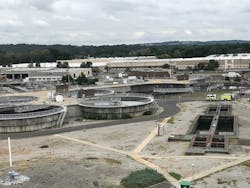Water Connections: Advances in Online Colorimetric Analyzer Technology
As total phosphorus and other nutrient limits are driven lower, managers of water and wastewater treatment plants (WWTP) are struggling to operate plants within permitted limits while controlling operational costs.
The Township of Wayne, N.J., like all municipal wastewater plants, has regulations, standards, permits and budgets they must adhere to, including regulations regarding total phosphorus levels. In the fall of 2017, new regulations, especially for total phosphorus, became even more stringent for the township.
A significant cost is the excessive flocculant dosing often used for phosphorus removal. Many factors impact total phosphorus removal, making it necessary, especially during the warmer months of the year, to run frequent grab-sample tests to ensure compliance. In addition to biological removal, many plants dose with flocculant for phosphorus removal, and it is frequently overdosed to avoid exceeding discharge limits, leading to a significant increase in operating costs. The time and expense of frequent grab-sample testing make optimization of flocculant dosing very difficult to achieve because of the time lag between sample results and dosing levels.
Endress+Hauser representatives met with the Township of Wayne to demonstrate the Liquiline System CA80TP Total Phosphorus analyzer. The municipality had tested multiple orthophosphate analyzers with poor results, and the plant’s main goal was to find an analyzer that would agree with lab total phosphorus data from grab samples.
The plant is now able to rely on the measurement and adjust the dosing in near real time based on total phosphorus trends in close agreement with laboratory grab-sample analysis. The Township of Wayne is now confident the analyzer will provide predictive alarms to warn of low reagent conditions, and when faults occur, they can be resolved quickly, resulting in minimal loss of measurement time.
The issues Township of Wayne experienced regarding control of phosphorus discharge are not unique. Wastewater treatment plants across the United States are seeing tighter permit levels for total phosphorus discharge. These limits make it very difficult to control phosphorus removal by solely relying on manual sampling and lab testing.
Orthophosphate analyzers do not produce a correct result because the sample preparation systems used with orthophosphate analyzers remove a portion of the total phosphorus. The Township of Wayne found the Endress+Hauser Liquiline System CA80TP Total Phosphorus analyzer measures true total phosphorus by providing a truly representative sample with complete sample digestion, resulting in results highly correlated with lab analysis.
The Township of Wayne was also able to maximize process uptime using the analyzer’s onboard diagnostics. With plans to upgrade to the analyzer to digital fieldbus communications with a built-in web server, the Township of Wayne will further enhance its ability to manage its phosphorus removal process and easily comply with tighter permit requirements. WW
Editor’s Note: To read the full Township of Wayne case study, please visit https://tinyurl.com/TownshipOfWayne.
Endress+Hauser is exhibiting at WEFTEC.19, booth 654. To learn more, visit us.endress.com.
